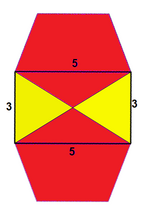
Back Configuració de vèrtex Catalan Vertica konfiguro Esperanto Configuración de vértices Spanish Configuration de sommet French Incidenza dei vertici Italian 꼭짓점 배치 Korean Configurația vârfului Romanian Конфигурация вершины Russian Konfiguracija oglišča Slovenian Конфігурація вершини Ukrainian
 Icosidodecahedron |
 Vertex figure represented as 3.5.3.5 or (3.5)2 |
In geometry, a vertex configuration[1][2][3][4] is a shorthand notation for representing the vertex figure[dubious – discuss] of a polyhedron or tiling as the sequence of faces around a vertex. For uniform polyhedra there is only one vertex type and therefore the vertex configuration fully defines the polyhedron. (Chiral polyhedra exist in mirror-image pairs with the same vertex configuration.)
A vertex configuration is given as a sequence of numbers representing the number of sides of the faces going around the vertex. The notation "a.b.c" describes a vertex that has 3 faces around it, faces with a, b, and c sides.
For example, "3.5.3.5" indicates a vertex belonging to 4 faces, alternating triangles and pentagons. This vertex configuration defines the vertex-transitive icosidodecahedron. The notation is cyclic and therefore is equivalent with different starting points, so 3.5.3.5 is the same as 5.3.5.3. The order is important, so 3.3.5.5 is different from 3.5.3.5 (the first has two triangles followed by two pentagons). Repeated elements can be collected as exponents so this example is also represented as (3.5)2.
It has variously been called a vertex description,[5][6][7] vertex type,[8][9] vertex symbol,[10][11] vertex arrangement,[12] vertex pattern,[13] face-vector.[14] It is also called a Cundy and Rollett symbol for its usage for the Archimedean solids in their 1952 book Mathematical Models.[15][16][17]
- ^ Uniform Solution for Uniform Polyhedra Archived 2015-11-27 at the Wayback Machine (1993)
- ^ The Uniform Polyhedra Roman E. Maeder (1995)
- ^ Crystallography of Quasicrystals: Concepts, Methods and Structures by Walter Steurer, Sofia Deloudi, (2009) pp. 18–20 and 51–53
- ^ Physical Metallurgy: 3-Volume Set, Volume 1 edited by David E. Laughlin, (2014) pp. 16–20
- ^ Archimedean Polyhedra Archived 2017-07-05 at the Wayback Machine Steven Dutch
- ^ Uniform Polyhedra Jim McNeill
- ^ Uniform Polyhedra and their Duals Robert Webb
- ^ Symmetry-type graphs of Platonic and Archimedean solids, Jurij Kovič, (2011)
- ^ 3. General Theorems: Regular and Semi-Regular Tilings Kevin Mitchell, 1995
- ^ Resources for Teaching Discrete Mathematics: Classroom Projects, History, modules, and articles, edited by Brian Hopkins
- ^ Vertex Symbol Robert Whittaker
- ^ Structure and Form in Design: Critical Ideas for Creative Practice By Michael Hann
- ^ Symmetry-type graphs of Platonic and Archimedean solids Jurij Kovič
- ^ Deza, Michel; Shtogrin, Mikhail (2000), "Uniform partitions of 3-space, their relatives and embedding", European Journal of Combinatorics, 21 (6): 807–814, arXiv:math/9906034, doi:10.1006/eujc.1999.0385, MR 1791208
- ^ Weisstein, Eric W., "Archimedean solid", MathWorld
- ^ Divided Spheres: Geodesics and the Orderly Subdivision of the Sphere 6.4.1 Cundy-Rollett symbol, p. 164
- ^ Laughlin (2014), p. 16